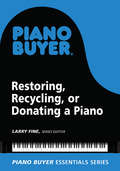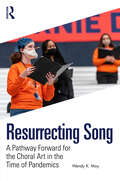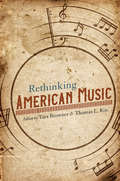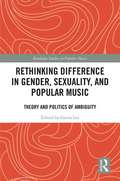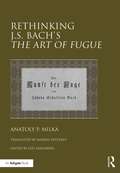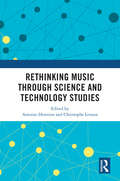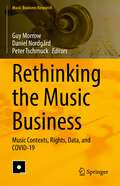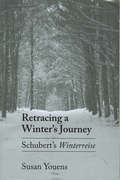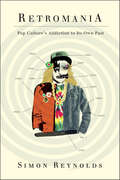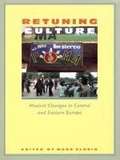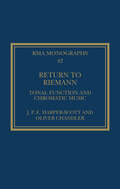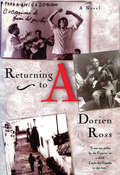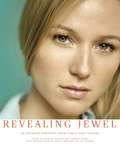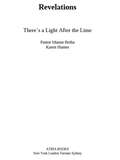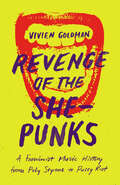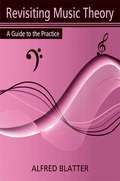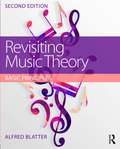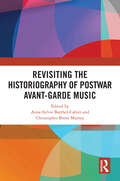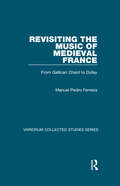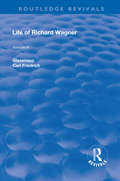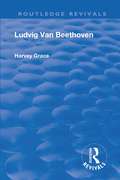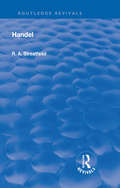- Table View
- List View
Restoring, Recycling, or Donating a Piano
by Larry FineThe Piano Buyer Essentials SeriesThe Piano Buyer Essentials Series brings together in one place the very best and most important articles from our 30 years of publishing on the subject of buying and owning a piano. Each e-book is a compilation of articles from current and past issues of Acoustic & Digital Piano Buyer, a semiannual consumer publication devoted to the purchase of new, used, and restored acoustic pianos and digital pianos. The e-books may also contain excerpts from The Piano Book, by Larry Fine, and from pieces published only on PianoBuyer.com. For reader convenience, articles and excerpts have been grouped by subject. However, because some pieces apply to more than one subject, there is some duplication of articles among the e-books in the series.
Resurrecting Song: A Pathway Forward for the Choral Art in the Time of Pandemics
by Wendy K. MoyThrough a collection of extensive interviews with choral conductors, educators, singers, and professional leaders, this book documents the choral music community’s journey through crisis and change during the COVID-19 pandemic and aids in its rebuilding in a new era where COVID-19 is endemic.When the pandemic emerged in early 2020, the impact on choral music was immediate and devastating, as the act of gathering and singing together became a source of contagion and potential severe illness or death. Weaving together a wide range of first-person accounts, this book addresses the impact of the coronavirus pandemic on choral music across contexts including community choruses, professional choirs, children and youth choirs, school choirs, and choral organizations. In their own words, we hear how the community responded to the challenges and banded together to innovate, use technology in new ways, and generate changes to practice. The book also explores how the pandemic caused many directors to realize that they needed to create a more inclusive place of belonging in their rehearsals, and provides reflections on the philosophy of singing and creating a choral community.Documenting both pandemic experiences and the lessons learned from surviving and thriving, this book showcases the resilience of choral music and helps point the way to new directions for the choral community in the wake of the pandemic.
Rethinking American Music (Music in American Life)
by Tara Browner Thomas RiisIn Rethinking American Music, Tara Browner and Thomas L. Riis curate essays that offer an eclectic survey of current music scholarship. Ranging from Tin Pan Alley to Thelonious Monk to hip hop, the contributors go beyond repertory and biography to explore four critical yet overlooked areas: the impact of performance; patronage's role in creating music and finding a place to play it; personal identity; and the ways cultural and ethnographic circumstances determine the music that emerges from the creative process. Many of the articles also look at how a piece of music becomes initially popular and then exerts a lasting influence in the larger global culture. The result is an insightful state-of-the-field examination that doubles as an engaging short course on our complex, multifaceted musical heritage. Contributors: Karen Ahlquist, Amy C. Beal, Mark Clagu,. Esther R. Crookshank, Todd Decker, Jennifer DeLapp-Birkett, Joshua S. Duchan, Mark Katz, Jeffrey Magee, Sterling E. Murray, Guthrie P. Ramsey Jr., David Warren Steel, Jeffrey Taylor, and Mark Tucker
Rethinking Difference in Gender, Sexuality, and Popular Music: Theory and Politics of Ambiguity (Routledge Studies in Popular Music)
by Gavin LeeIn studies of gender and sexuality in popular music, the concept of difference is often a crucial analytic used to detect social agency; however, the alternative analytic of ambiguity has never been systematically examined. While difference from heterosexual norms is taken to be the multivalent sign of resistance, oppression, and self-invention, it can lead to inflated claims of the degree and power of difference. This book offers critically-oriented case studies that examine the theory and politics of ambiguity. Ambiguity means that there are both positive and negative implications in any gender and sexuality practices, both sameness and difference from heteronormativity, and unfixed possibility in the diverse nature of discourse and practice (rather than just "difference" among fixed multiplicities). Contributors present a diverse array of approaches through music, sound, psyche, body, dance, performance, race, ethnicity, power, discourse, and history. A wide variety of popular music genres are broached, including gay circuit remixes, punk rock, Goth music, cross-dress performance, billboard 100 songs, global pop, and nineteenth-century minstrelsy. The authors examine the ambiguities of performance and reception, and address the vexed question of whether it is possible for genuinely new forms of gender and sexuality to emerge musically. This book makes a distinctive contribution to studies of gender and sexuality in popular music, and will be of interest to fields including Popular Music Studies, Musicology/Ethnomusicology, Cultural Studies, Queer Studies, and Media Studies.
Rethinking Difference in Music Scholarship
by Olivia Bloechl Melanie Lowe Jeffrey Kallberg Olivia Bloechl Melanie LoweTwo decades after the publication of several landmark scholarly collections on music and difference, musicology has largely accepted difference-based scholarship. This collection of essays by distinguished contributors is a major contribution to this field, covering the key issues and offering an array of individual case studies and methodologies. It also grapples with the changed intellectual landscape since the 1990s. Criticism of difference-based knowledge has emerged from within and outside the discipline, and musicology has had to confront new configurations of difference in a changing world. This book addresses these and other such challenges in a wide-ranging theoretical introduction that situates difference within broader debates over recognition and explores alternative frameworks, such as redistribution and freedom. Voicing a range of perspectives on these issues, this collection reveals why differences and similarities among people matter for music and musical thought.
Rethinking J.S. Bach's The Art of Fugue
by Anatoly MilkaThe enigmatic character of The Art of Fugue became apparent as early as in its first edition, printed more than a year after the composer’s death. Carl Philipp Emanuel Bach, who published both the first and the second editions, raised several unsolved questions regarding this opus. Anatoly P Milka presents a consistent and coherent solution to the unresolved questions about the history, structure and appearance of J.S. Bach’s The Art of Fugue, opening new perspectives for further exploration of this musical masterpiece. Milka challenges the present scholarly consensus that there exist two different versions of The Art of Fugue (the Autograph and the Original Edition) and argues that Bach had considered four versions, of which only two are apparent and have been discussed so far. Only Bach’s illness and death prevented him from fulfilling his plan and publishing a fourth, conclusive version of his opus.
Rethinking Music through Science and Technology Studies
by Antoine Hennion and Christophe LevauxThis volume seeks to offer a new approach to the study of music through the lens of recent works in science and technology studies (STS), which propose that facts are neither absolute truths, nor completely relative, but emerge from an intensely collective process of construction. Applied to the study of music, this approach enables us to reconcile the human, social, factual, and technological aspects of the musical world, and opens the prospect of new areas of inquiry in musicology and sound studies. Rethinking Music through Science and Technology Studies draws together a wide range of both leading and emerging scholars to offer a critical survey of STS applications to music studies, considering topics ranging from classical music instrument-making to the ethos of DIY in punk music. The book’s four sections focus on key areas of music study that are impacted by STS: organology, sound studies, music history, and epistemology. Raising crucial methodological and epistemological questions about the study of music, this book will be relevant to scholars studying the interactions between music, culture, and technology from many disciplinary perspectives.
Rethinking the Music Business: Music Contexts, Rights, Data, and COVID-19 (Music Business Research)
by Peter Tschmuck Guy Morrow Daniel NordgårdCOVID-19 had a global impact on health, communities, and the economy. As a result of COVID-19, music festivals, gigs, and events were canceled or postponed across the world. This directly affected the incomes and practices of many artists and the revenue for many entities in the music business. Despite this crisis, however, there are pre-existing trends in the music business – the rise of the streaming economy, technological change (virtual and augmented reality, blockchain, etc.), and new copyright legislation. Some of these trends were impacted by the COVID-19 crisis while others were not. This book addresses these challenges and trends by following a two-pronged approach: the first part focuses on the impact of COVID-19 on the music business, and the second features general perspectives. Throughout both parts, case studies bring various themes to life. The contributors address issues within the music business before and during COVID-19. Using various critical approaches for studying the music business, this research-based book addresses key questions concerning music contexts, rights, data, and COVID-19. Rethinking the music business is a valuable study aid for undergraduate and postgraduate students in subjects including the music business, cultural economics, cultural management, creative and cultural industries studies, business and management studies, and media and communications.
Retracing a Winter's Journey: Franz Schubert's "Winterreise"
by Susan YouensI like these songs better than all the rest, and someday you will too, Franz Schubert told the friends who were the first to hear his song cycle, Winterreise. These lieder have always found admiring audiences, but the poetry he chose to set them to has been widely regarded as weak and trivial. In Retracing a Winter's Journey, Susan Youens looks not only at Schubert's music but at the poetry, drawn from the works of Wilhelm Müller, who once wrote in his diary, "perhaps there is a kindred spirit somewhere who will hear the tunes behind the words and give them back to me!"Youens maintains that Müller, in depicting the wanderings of the alienated lover, produced poetry that was simple but not simple-minded, poetry that embraced simplicity as part of its meaning. In her view, Müller used the ruder folk forms to give his verse greater immediacy, to convey more powerfully the wanderer's complex inner state. Youens addresses many different aspects of Winterreise: the cultural milieu to which it belonged, the genesis of both the poetry and the music, Schubert's transformation of poetic cycle into music, the philosophical dimension of the work, and its musical structure.
Retromania: Pop Culture's Addiction to Its Own Past
by Simon ReynoldsOne of The Telegraph's Best Music Books 2011 We live in a pop age gone loco for retro and crazy for commemoration. Band re-formations and reunion tours, expanded reissues of classic albums and outtake-crammed box sets, remakes and sequels, tribute albums and mash-ups . . . But what happens when we run out of past? Are we heading toward a sort of culturalecological catastrophe where the archival stream of pop history has been exhausted? Simon Reynolds, one of the finest music writers of his generation, argues that we have indeed reached a tipping point, and that although earlier eras had their own obsessions with antiquity—the Renaissance with its admiration for Roman and Greek classicism, the Gothic movement's invocations of medievalism—never has there been a society so obsessed with the cultural artifacts of its own immediate past. Retromania is the first book to examine the retro industry and ask the question: Is this retromania a death knell for any originality and distinctiveness of our own?
Retuning Culture: Musical Changes in Central and Eastern Europe
by Mark SlobinAs a measure of individual and collective identity, music offers both striking metaphors and tangible data for understanding societies in transition--and nowhere is this clearer than in the recent case of the Eastern Bloc. Retuning Culture presents an extraordinary picture of this phenomenon. This pioneering set of studies traces the tumultuous and momentous shifts in the music cultures of Central and Eastern Europe from the first harbingers of change in the 1970s through the revolutionary period of 1989-90 to more recent developments.During the period of state socialism, both the reinterpretation of the folk music heritage and the domestication of Western forms of music offered ways to resist and redefine imposed identities. With the removal of state control and support, music was free to channel and to shape emerging forms of cultural identity. Stressing both continuity and disjuncture in a period of enormous social and cultural change, this volume focuses on the importance and evolution of traditional and popular musics in peasant communities and urban environments in Hungary, Poland, Romania, Russia, the Czech Republic, Ukraine, the former Yugoslavia, Macedonia, and Bulgaria. Written by longtime specialists in the region and considering both religious and secular trends, these essays examine music as a means of expressing diverse aesthetics and ideologies, participating in the formation of national identities, and strengthening ethnic affiliation.Retuning Culture provides a rich understanding of music's role at a particular cultural and historical moment. Its broad range of perspectives will attract readers with interests in cultural studies, music, and Central and Eastern Europe.Contributors. Michael Beckerman, Donna Buchanan, Anna Czekanowska, Judit Frigyesi, Barbara Rose Lange, Mirjana Lausevic, Theodore Levin, Margarita Mazo, Steluta Popa, Ljerka Vidic Rasmussen, Timothy Rice, Carol Silverman, Catherine Wanner
Return to Riemann: Tonal Function and Chromatic Music (ISSN)
by J. P. Harper-Scott Oliver ChandlerThis book is a music-theoretical and critical-theoretical study of late tonal music, and, in particular, of the music of Wagner’s Götterdämmerung.First, in terms of music theory, it proposes a new theory of tonal function that returns to the theories of Hugo Riemann to rediscover a development of his thought that has been covered over by the recent project of neo-Riemannian theory. Second, in terms of its philosophical approach, it reawakens the critical-theoretical examination of the relation between music and the late capitalist society that is sedimented in the musical materials themselves, and which the music, in turn, subjects to aesthetically embodied critique. The music, the theory, and the listeners and critics who respond to them are all radically reimagined.This book will be of interest to professional music theorists, undergraduates, and technically inclined musicians and listeners, that is, anyone who is fascinated by the chromatic magic of late-nineteenth-century music.
Returning to A
by Dorien RossWith one suitcase and a map drawn on a bar napkin as her only guide, sixteen-year old Loren travels to Moron del la Frontera in Andalusia to learn to play flamenco guitar from the Gypsies. Here she joins an extended family of flamenco artists and foreign aficionados whose adventures over a twenty-year period are interwoven with Loren's own odyssey. Her life with the Gypsies is haunted by the mysterious circumstances of her brother Aaron's death. Although they shared the same New York Jewish upbringing, he went to California during the expansive optimism of the sixties, while she went back in time to explore a rich music and culture. Their relationship is a dark love story that casts disquieting shadows over their years apart.As Loren struggles to master an instrument traditionally off-limits to women, she finds her own path, inspired by the earthy wisdom of her Gypsy companions."This stunning first novel is the story of a journey from America to Andalusia, where a community of Gypsies has inhabited a musical and poetic tradition so intensely and for so long that the nature of reality is transformed for all those they encounter. In this landscape even the buildings are capable of passion."-The Nation". . . fascinating insights into Gypsy culture." - Los Angeles TimesDorien Ross studied flamenco guitar with Andalusian Gypsies. Her work has appeared in Best American Essays and in Tikkun.
Revealing Jewel: An Intimate Portrait from Family and Friends
by Kenneth Calhoun Cambria JensenA complete and revealing portrait of Jewel, of one of today's most multifaceted and talented performers, is drawn from over 30 celebrity interviews and a host of never-before-seen photos. 40 photos.
Revelations: There's a Light after the Lime
by Mason BethaImagine having it all and leaving it all behind -- to answer a higher calling... REVELATIONS His rise to fame was one of rap's great success stories. He had millions of fans and the prospect of multi-millions of dollars. But just as Mase -- as he was then called -- was poised to sign a deal with Sean "Puffy" Combs' famed Bad Boy Records, he walked away. Revelations is Mason Betha's powerful memoir about a miraculous transformation: his own -- from the material-minded Mase to the pastor he has become. Here, Betha reveals the rhyme and reason behind his choice to trade in his sensational music career for a richer, more spiritual one. As founder of a nondenominational movement called S.A.N.E. (Saving a Nation Endangered) Ministries, Betha has traveled throughout the country to share his messages of peace and prosperity with today's youth. Revelations is his testament to the enduring power of faith, and to the limitless possibilities in a life transformed by God's guiding hand.
Revenge of the She-Punks: A Feminist Music History from Poly Styrene to Pussy Riot
by Vivien GoldmanA dazzling survey of women in punk, from the genre’s inception in 1970s London to the current voices making waves around the globe.As an industry insider and pioneering post-punk musician, Vivien Goldman has an unusually well-rounded perspective on music journalism. In Revenge of the She-Punks, she probes four themes—identity, money, love, and protest—to explore what makes punk such a liberating art form for women.With her visceral style, Goldman blends interviews, history, and her personal experience as one of Britain’s first female music writers in a book that reads like a vivid documentary of a genre defined by dismantling boundaries. A discussion of the Patti Smith song “Free Money,” for example, opens with Goldman on a shopping spree with Smith. Tamar-Kali, whose name pays homage to a Hindu goddess, describes the influence of her Gullah ancestors on her music, while the late Poly Styrene's daughter reflects on why her Somali-Scots-Irish mother wrote the 1978 punk anthem “Identity,” with the refrain “Identity is the crisis you can't see.” Other strands feature artists from farther afield (including in Colombia and Indonesia) and genre-busting revolutionaries such as Grace Jones, who wasn't exclusively punk but clearly influenced the movement while absorbing its liberating audacity. From punk's Euro origins to its international reach, this is an exhilarating world tour.“In this witty, must-read introduction to punk music, Vivien Goldman sifts through decades of firsthand encounters with feminist musicians to identify how and where these colorful she-punks have arrived—and where they might be headed.”—Tin Weymouth, Talking Heads, Tom Tom Club“Revelatory . . . [Revenge of the She-Punks] feels like an exhilarating conversation with the coolest aunt you never had, as she leaps from one passion to the next.” —Rolling Stone“This book should restore Goldman’s place in the rock-crit firmament just as she sets out to give punk’s women their long-denied dues.” —The Guardian“[Revenge of the She-Punks] doesn’t just retell the story of punk with an added woman or two; it centers the relationships between gender and the genre, showing how, through the right lens, the story of punk is a story about women’s ingenuity and power.” —NPR“An engaging and politically charged exploration of women in music looking to the past, present, and future.” —Bust Magazine“Riotously entertaining . . . A vibrant and inspiring introduction to feminist music history that invites more scholarship and music making.” —Foreword Reviews
Revenge of the She-Punks: A Feminist Music History from Poly Styrene to Pussy Riot
by Vivien GoldmanA dazzling survey of women in punk, from the genre’s inception in 1970s London to the current voices making waves around the globe.As an industry insider and pioneering post-punk musician, Vivien Goldman has an unusually well-rounded perspective on music journalism. In Revenge of the She-Punks, she probes four themes—identity, money, love, and protest—to explore what makes punk such a liberating art form for women.With her visceral style, Goldman blends interviews, history, and her personal experience as one of Britain’s first female music writers in a book that reads like a vivid documentary of a genre defined by dismantling boundaries. A discussion of the Patti Smith song “Free Money,” for example, opens with Goldman on a shopping spree with Smith. Tamar-Kali, whose name pays homage to a Hindu goddess, describes the influence of her Gullah ancestors on her music, while the late Poly Styrene's daughter reflects on why her Somali-Scots-Irish mother wrote the 1978 punk anthem “Identity,” with the refrain “Identity is the crisis you can't see.” Other strands feature artists from farther afield (including in Colombia and Indonesia) and genre-busting revolutionaries such as Grace Jones, who wasn't exclusively punk but clearly influenced the movement while absorbing its liberating audacity. From punk's Euro origins to its international reach, this is an exhilarating world tour.“In this witty, must-read introduction to punk music, Vivien Goldman sifts through decades of firsthand encounters with feminist musicians to identify how and where these colorful she-punks have arrived—and where they might be headed.”—Tin Weymouth, Talking Heads, Tom Tom Club“Revelatory . . . [Revenge of the She-Punks] feels like an exhilarating conversation with the coolest aunt you never had, as she leaps from one passion to the next.” —Rolling Stone“This book should restore Goldman’s place in the rock-crit firmament just as she sets out to give punk’s women their long-denied dues.” —The Guardian“[Revenge of the She-Punks] doesn’t just retell the story of punk with an added woman or two; it centers the relationships between gender and the genre, showing how, through the right lens, the story of punk is a story about women’s ingenuity and power.” —NPR“An engaging and politically charged exploration of women in music looking to the past, present, and future.” —Bust Magazine“Riotously entertaining . . . A vibrant and inspiring introduction to feminist music history that invites more scholarship and music making.” —Foreword Reviews
Reverberations: The Memoirs of Dietrich Fischer-dieskau
by Dietrich Fischer-DieskauThe memoirs of Dietrich Fischer-Dieskau, a great opera and Lieder singer. He shares his penetrating insights into music, his painstaking preparations for the roles he has made his own, his acute assessments of his famous contemporaries, and how he has dealt with stunning public triumph and overwhelming personal tragedy. Born 1925, died 2012, his recordings of Schubert, Schumann and Hugo Wolf songs are still widely available today.
Revisiting Music Theory: A Guide to the Practice
by Alfred BlatterRevisiting Music Theory: A Guide to the Practice contains the basics of music theory with the vocabulary used in harmonic and formal analysis. The book assumes few music reading skills, and progresses to include the basic materials of music from J. S. Bach to the twentieth century. Based on Blatter’s own three decades of teaching music theory, this book is aimed at a one or two year introductory course in music theory, can serve for individual study, or as a review for graduate students returning to school. Drawing examples from well-known classical works, as well as folk and popular music, the book shows how theory is applied to practice. The book is divided into five parts. The first part introduces music notation, reviewing the basics of pitch, time, and dynamics as represented in written music. Part 2 introduces the concept of melody, covering modes, scales, scale degrees, and melodic form. Part 3 introduces harmony, dealing with harmonic progression, rhythm, and chord types. Part 4 addresses part writing and harmonic analysis. Finally, Part 5 addresses musical form, and how form is used to structure a composition. Revisiting Music Theory will be a valuable textbook for students, professors, and professionals.
Revisiting Music Theory: Basic Principles
by Alfred BlatterRevisiting Music Theory: Basic Principles, Second Edition, surveys the basics of music theory and explains the terms used in harmonic and formal analysis in a clear and concise manner. Students will find Revisiting Music Theory to be an essential resource for review or reference, while instructors of introductory theory courses will find in these pages a solid foundation for cultivating musical thinking. Musicians of all kinds—amateur and professional alike—will find great value in augmenting and informing their knowledge of the art of music theory. The text covers the basic principles of music theory, including:• Musical notation• Key signatures and scales• Intervals, chords, and progressions• Melodic and harmonic analysis• Counterpoint and voice leading techniques• Musical forms and structures This second edition has been revised and reorganized to promote learning. Each section now includes an all-new selection of exercises, allowing readers to practice key skills and improve understanding. For students, instructors, and practicing musicians, Revisiting Music Theory offers an indispensable guide to the foundations of musical analysis.
Revisiting the Historiography of Postwar Avant-Garde Music
by Anne-Sylvie Barthel-Calvet and Christopher Brent MurrayThis collection of essays delves into the historiographical traditions that have dominated how the stories of European postwar avant-garde music are told, seeking to approach commonplaces of that history writing from new perspectives. The contributors revisit subjects as varied as the impact of long-playing records on the emergence of open works, Messiaen’s interest in non-European musical traditions, Xenakis’s turn to information theory, Kagel’s strategic invention of a new genre, Berio’s dependence on funding from American foundations, and the ways in which figures like Boulez, Stockhausen, Pousseur, and Nono constructed their musical ancestries. Leading experts in their respective fields, the volume’s authors have sought to rethink the historiography of European experimental music of the 1950s, 1960s, and 1970s in ways that resituate that small but influential milieu in broader historical and cultural contexts. In doing so, they suggest new directions and insights for students and specialists of twentieth-century music and music historiography.
Revisiting the Music of Medieval France: From Gallican Chant to Dufay (Variorum Collected Studies #1007)
by Manuel Pedro FerreiraThis book presents together a number of path-breaking essays on different aspects of medieval music in France written by Manuel Pedro Ferreira, who is well known for his work on the medieval cantigas and Iberian liturgical sources. The first essay is a tour-de-force of detective work: an odd E-flat in two 16th-century antiphoners leads to the identification of a Gregorian responsory as a Gallican version of a seventh-century Hispanic melody. The second rediscovers a long-forgotten hypothesis concerning the microtonal character of some French 11th-century neumes. In the paper "Is it polyphony?" an even riskier hypothesis is arrived at: Do the origins of Aquitanian free organum lie on the instrumental accompaniment of newly composed devotional versus? The Cistercian attitude towards polyphonic singing, mirrored in musical sources kept in peripheral nunneries, is the subject of the following essay. The intellectual and sociological nature of the Parisian motet is the central concern of the following two essays, which, after a survey of concepts of temporality in the trouvère and polyphonic repertories, establish it as the conceptual foundation of subsequent European schools of composition. It is possible then to assess the real originality of Philippe de Vitry and his Ars nova, which is dealt with in the following chapter. A century later, the role of Guillaume Dufay in establishing a chord-based alternative to contrapuntal writing is laboriously put into evidence. Finally, an informative synthesis is offered concerning the mathematical underpinnings of musical composition in the Middle Ages.
Revival: Art and Politics (Routledge Revivals)
by Carl Francis GlasenappFourth volume of Carl Francis Glasenapp's Life of Richard Wagner.
Revival: Beethoven (1933) (Routledge Revivals)
by Harvey GraceThe original intention was that this book should be entirely biographical. If it be true, however, that out main interest is (or ought to be) in what a composer did rather than in what he was, the truth applies especially to Beethoven, and above all at the present time. The scheme of the book has therefore been modified so as to include a survey of his work. An attempt to make such survey cover the whole of Beethoven’s output would result in little more than a catalogue, with annotations to brief as to convey hardly anything of the essential quality of the music. It seemed, therefore, that the limited space would be best used, and the needs of the general reader more fully met, by a much less rigid and comprehensive method. My aim has been to indicate some, at least, of the more important characteristics of Beethoven’s works, and to show their influence on his successors.
Revival: Handel (Routledge Revivals)
by Richard Alexander StreatfieldIt is the inner meaning of Handel’s music, and its power of searching the profoundest recesses of the soul, that in the following pages I have endeavoured, so far as I am able, to elucidate. Its merely technical qualities have already been discussed enough and to spare. Books on Handel written by musicians already abound, but musicians as a rule take more interest in the means by which an end is attained than the end itself. They tell us a great deal about the methods by which a composer expresses himself, but very little about what he actually has to express. I have tried, how feebly and with what little success no one knows better than myself, to find the man Handel in his music, to trace his character, his view of life, his thoughts, feelings, and aspirations, as they are set forth in his works.
